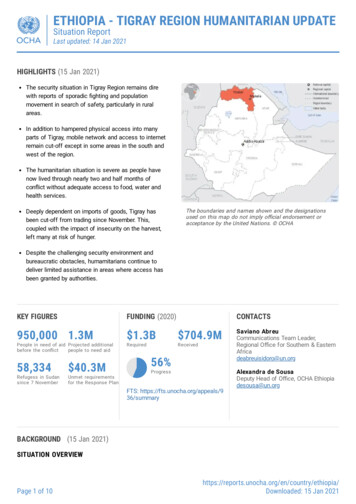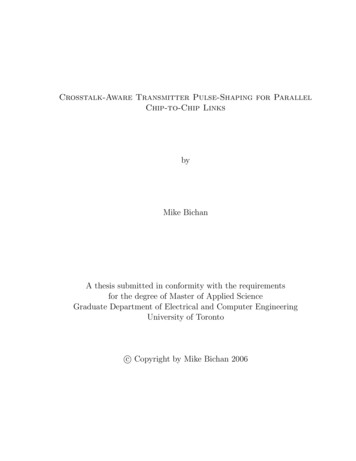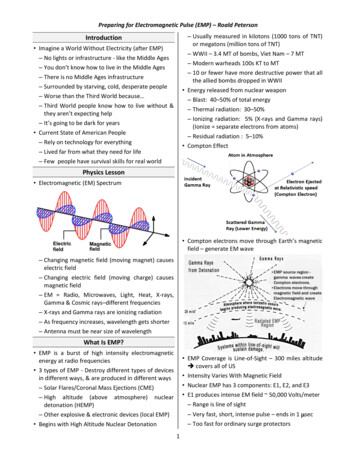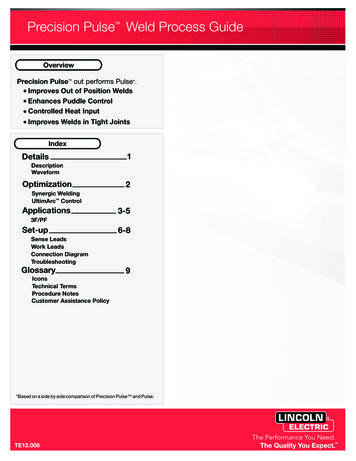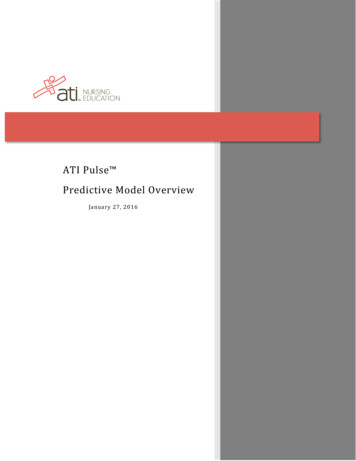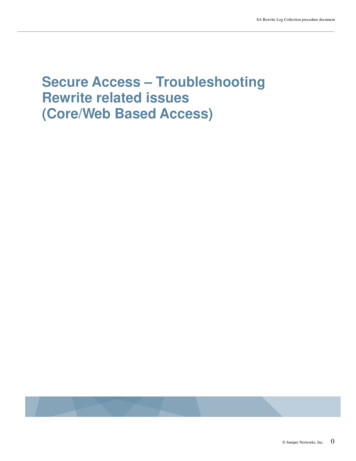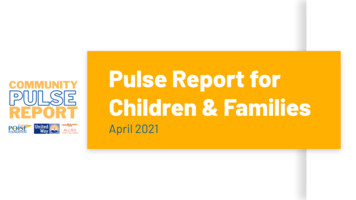
Transcription
Pulse Report forChildren & FamiliesApril 2021
Taking Our PulseThe goal of the Community Pulse Report is toexamine key indicators as a way of taking thepulse of our community during these difficulttimes and to further inform policy makers,nonprofit leaders, reporters, and the public ingeneral. This month’s report is organized intothree sections:Our aim is to utilize data that will give us asnapshot of what is happening in thefive-county region—Allegheny, Armstrong,Butler, Fayette and Westmoreland Counties.Important to the project will be finding datathat deepens our understanding of theintersecting disparities in health care, society,and the economy and their impacts on Blackand Latino/a/x children and families.Vaccine RolloutSchool EngagementSummer Programming for Youth2
A Note on Disaggregated Data & GeographiesWe are committed to utilizing data that canbe disaggregated by race, gender, and age.We continue to strive to identify proxyindicators where disaggregated data is notavailable, and advocate for thedisaggregation of data by race, gender, andage.Where such data is available,we note that throughout thereport with this symbolWhere it is not available, wenote with this symbolThroughout this report, the geography ofanalyzed data is noted in the upperleft-hand corner of each chart or graph:United StatesPennsylvaniaFive-County Region(Allegheny, Armstrong, Butler,Fayette, Westmoreland)3
From the FieldFeedback and observationsfrom our on-the-groundproviders are crucial tounderstanding the data weare collecting in context.Despite strong supportsfrom the AmericanRescue Plan Act (ARPA),families are still facinghardships related tohousing, utilities, health,education, and more. Keypartners in the regioncontinue to providecritical support for ourcommunities.“The COVID-19 pandemic hasexposed the expandingacademic achievement gapfaced by our region’s students.Not only are vulnerable studentsbeing left out of academicsuccess, but they continue toface challenges to their socialand emotional wellbeing. Aseducators, we are respondingby seeking creative ways toprovide summer programmingthat provides structuredremediation and a holisticapproach to ensuring ourstudents are ready for the nextschool year."YWCA“ACTION is privileged to be a part ofthe massive county-wide evictionprevention efforts currently takingplace. This past year has beenunprecedented and the need to securefamilies and individuals in their homeshas never been more elevated orimportant. In the first three weeks ofthe new Emergency Rental AssistanceProgram, we’ve already seen over 100households stabilized. This is settingan important precedent for what itlooks like moving forward for ourcounty to prioritize housingstabilization and having effective andmeaningful solutions and alternativesto evictions.”ACTION Housing4
COVID-19 vaccinations continue across the stateand the region. Over 35% of the five-countyregion’s adults have received at least one dose ofthe vaccine.Higher proportions of women and older adults arereceiving the vaccine in the region; while Blackadults remain underrepresented in vaccinations,despite relatively low rates of vaccine hesitancy.5
COVID-19 Vaccinations, Five-County RegionEstimated % of Adults 18 Vaccinated withat Least One Dose, as of 4.21.21In the five-county region,733,013people have been vaccinatedwith at least one dose. That’s anestimated 44.4% of adults 18 in the ce: Pennsylvania Department of Health, as of 4.21.21. *Excluding Philadelphia County.
COVID-19 Vaccinations by (Known) Race, Five-County Regionvs. 3% of thepopulation in thefive-county regionMultiple/OtherAsianBlackvs. 9% of thepopulation in thefive-countyregionWhite adults in the regionare being vaccinated athigher rates than Blackand Asian adults, despiteBlack people beingoverrepresented inCOVID-19 deaths.0.1%Five-CountyRegion(as of 4.02)Whitevs. 86% of thepopulation inthe five-countyregionSource: Pennsylvania Department of Health. At least one dose. “Other” includes “Multiple,” Pacific Islander, and Native American.Population numbers from Census ACS 2019 1-year estimates.Vaccinations for“Unknown” race are notpictured here. Thanks toadvocacy and actionfrom public officials, thisnumber has declinedsignificantly, fromalmost 30% in Februaryto 14% in April,statewide.7
Black Equity Coalition Analysis, Allegheny CountyThe Pittsburgh- based BlackEquity Coalition is advocatingfor greater data availabilityand greater focus on racialequity as the vaccinedistribution continues. Readtheir recent report here.Early vaccine distribution has not been equitable by race. Considering bothage distribution and employment, Black residents are underrepresented bothstatewide and in Allegheny County specifically, among recipients for whomrace data has been reported.8
COVID-19 Vaccinations by Gender, Five-County Region2%UnknownFive-CountyRegion(as of 4.02)FemaleMaleMore women than men havereceived at least one dose ofthe vaccine statewide and inthe five-county region,although the proportion ofmen vaccinated hasincreased since earlier in theyear.This may partially beexplained by the greaterproportion of women workingin health care and/or who areover age 75. Both of thosegroups have been prioritizedfor vaccine distribution.9Source: Pennsylvania Department of Health. At least one dose.
Percent of All VaccinationsCOVID-19 Vaccinations by Age, Five-County Region43% of vaccinatedadults in thefive-county regionare 65 or over. InAllegheny County, alarger proportion ofyounger people havebeen vaccinated, with35% of thosevaccinated under 50.10County data as of 4.2. At least one dose. Data only includes information reported to PA-SIIS, the Pennsylvania StatewideImmunization Information System. Source: Pennsylvania Department of Health
Many students are still learning virtually, and lackof consistent, quality access to the internetimpacts attendance and learning outcomes.Educationally marginalized students in particularcould be at risk of “missing” the entire schoolyear.The American Rescue Plan Act has allocated 410million for Elementary and Secondary SchoolEmergency Relief (ESSER) for public schooldistricts and charter schools in the five-countyregion, to support long-term education recoverywork.11
Many Students are Still Learning RemotelyA survey conducted by the US Department of Education found that in early February:44%elementarystudents were fullyremote48%middle schoolstudents were no/a/xstudents27%WhitestudentsThese disparities may be partly due to where students live,as schools in cities are less likely than schools in ruralareas to offer full-time, in-person classes. They may alsobe due to which families are choosing to stay remote.12
What We’ve Heard About Broadband Access.Internet connectivity continues to be a problem in many areasof the five-county region.“We have paid for internet servicesfor any of our families that could notafford it. The one challenge we havehad is areas that do not have cablenor high speed cell data to run ahotspot. However, these are notalways folks who live in poverty. Insome cases they are large homessitting on many acres of land.”In a recent survey of oneButler County SchoolDistrict, 10% ofrespondents said they didnot have reliable Internetstrong enough to maintain aconnection to GoogleMeets.— School District, Butler County13
Students are Missing Out96,000educationally marginalized students inPennsylvania — students in foster care,English language learners, studentsexperiencing homelessness, students withdisabilities, and migrant students — mayhave received no formal education sincethe start of the pandemic.Bellwether Education Partners50%ofoffamiliesfamiliesusedin themorementaland behavioralPittsburghregion arehealthservicesthan theysomewhat or notdidpre-pandemicsatisfiedwith how theirchildren are doing inschool.in SeptemberSource: The Pittsburgh Study’s Family Strengths Survey,made possible in part through support from the Children'sHospital of Pittsburgh Foundation, Pitt Pediatrics, TheGrable Foundation, and The Shear Family Foundation.Responses from February 2021, n 30114
What We’ve Heard About Student Engagement This has been a frustrating year for many peopleand engagement has been difficult. Lack ofaccess to the internet and computers was a bigreason for absences at the beginning of the year,though much work has been done to engagefamilies around “logging on.” Flexibility and partnership is key: when studentsare involved with a combination of school partners,service providers, and families, attendanceincreases. Every parent wants better for their child: whenchildren are missing school there’s oftensomething in the way, but it’s not a lack of caringabout education.Source: Focus on AttendanceA BRIGHT SPOT:WHAT’S WORKINGFocus on Attendance, acommunity-based attendanceimprovement programfor all schools in AlleghenyCounty, facilitates positivecommunication betweensystems, provides technicalassistance, and offerscoordination of services. Directsupports to children and familiesare provided by a variety ofresources and services.15
Engagement is critical for children and youth tothrive. Whether opportunities for peer-to-peerinteraction, a renewed sense of structure, oracademic support, children need quality summeropportunities.The American Rescue Plan Act is providing 1.2billion, nationally, for summer enrichment programsand after school programs, which can be usedthrough the end of 2024.16
Out-of-School Time (OST) Programming has Many Benefits for Youth69%of students improve homeworkcompletion and classparticipation after attendingOST programming.Kids from low-income familiessee the greatest gains inacademic performance.Kids who participate in OSTprogramming have asafe spaceto engage in physical activity, haveaccess to healthy meals and snacks,and connect with communityresources.90%of parents say that OST programsgive their kids time to interact withpeers and build social skills.17Source: This is Afterschool17
But Summer Programming Supply Does not Always Meet DemandEven in 2013, demand outpacedparticipation for summer programming.35%of 5- to 18-year olds inthe region did notparticipate in a summerlearning program whootherwise would have ifone was available.and COVID-19 has impacted summerprogramming participation even more.“Since the inception of the [HumanServices Center Corporation’s] KOOLSummer Program over 20 years ago,there has been a waiting list every yearfor the 155 slots for first through fifthgraders. This year the application is beingsent to over 3,000 families for 80available slots (due to social distancing).”The Human Services Center Team18Source: Based on national rates, from Afterschool Alliance’s Summer Learning Programs Help Kids Succeed;and population numbers from KIDS Count 2018
This Summer in Particular, Students Have Varying NeedsStudents’ needs vary.Some advocates arecalling for an academicfocused “summer oflearning,” while others arestressing the importanceof a “summer of play.”Both are important.Students’ mentalhealth is suffering.Students arefalling behindacademically.25% of 14- to 17-year-olds62% of parents thinkreport symptoms ofmoderate to severedepression, almost doublethe rate of two years ago(13%).Common Sense Mediatheir children are behindwhere they would beduring a normal schoolyear.The National Parent TeacherAssociation and Learning Heroes19
Planning for the SummerAs we start to plan for summer, we recognize the importance of in-personengagement, where possible, for children’s physical and mental health.A national survey of parents with children aged 5–12 years indicated thatchildren receiving virtual instruction were more likely than those receivingin-person instruction to have experienced:decreased physicalactivityworsened mental oremotional health62.9% vs. 30.3%24.9% vs. 15.9%less time spentoutsideless in-person timewith friends58.0% vs. 27.4%86.2% vs. 69.5%20
What’s Already Working: Community Learning Hubs62 Community Learning Hubs across Allegheny County areserving over 1,200 students. Hubs support children’s learning,provide safe spaces during the day for children to connect withadults and each other, and provide routine and enrichment.21Source: Public Source; enrollment numbers via Trying Together, as of December 2020
More Information & Previous Reports Previous reports: Community Pulse Report: September Community Pulse Report: October Community Pulse Report: November/December Community Pulse Report: January Community Pulse Report: FebruaryReport developed and designedby Fourth Economy.22
The goal of the Community Pulse Repor t is to examine key indicators as a way of taking the . unprecedented and the need to secure families and individuals in their homes has never been more elevated or . Pitt Pediatrics, The Grable Foundation, and The Shear F
